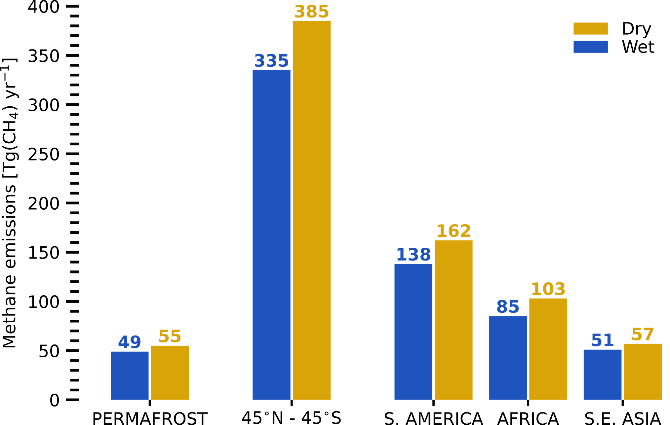From the Arctic to the tropics: permafrost soils and methane

Global warming will lead to a partial thawing of the permafrost soils in the Arctic. The scientific consensus is that this permafrost degradation will release large amounts of carbon to the atmosphere. What is much more uncertain, however, is the extent to which the carbon emissions will accelerate climate change, especially since carbon is released not only as carbon dioxide (CO2) but also in the form of methane. Methane has a much higher global warming potential than carbon dioxide, which is why emissions of methane, considered per molecule released, lead to substantially more warming than emissions of CO2. Methane is produced when the decomposition process takes place under oxygen-free conditions, making wetlands, lakes, and ponds a major source of natural methane emissions. This, in turn, means that the effect of permafrost thaw on global temperatures may also depend on how much the Arctic soils dry out in the future. Until now, it has been assumed that methane emissions will be particularly high if the soils remain wet after thawing.
A new study led by researchers from the Max Planck Institute for Meteorology in collaboration with scientists from the University of Hamburg now shows that this is not necessarily the case. If the soils in the Arctic remain comparatively wet after the permafrost thaws, evaporation rates are high, which, in turn, results in an extensive cloud cover in summer, cooling the land surface. If the soils become drier, evaporation is lower, there are fewer clouds, and the land is warmer than when soils remain wet. Areas producing methane are substantially larger in the wet scenario, but the lower temperatures mean that the carbon cycle is much slower, so less methane leaks out from each square meter of moist soil. The full analysis shows that the total methane emissions are surprisingly similar in both scenarios.
Most remarkably, the scientists were able to show that the hydrological conditions in the permafrost-affected regions may have an influence on the global methane budget that goes beyond the local methane emissions. Indeed, the speed with which the Arctic warms also affects important weather systems and large-scale circulation patterns such as the West African monsoon. These, in turn, determine precipitation rates in the tropics and subtropics and, consequently, the extent of wetlands and the respective methane emissions. These remote effects of Arctic warming on the global methane budget could be as large as the total contribution of the methane emissions from the northern permafrost regions. Commenting on this counterintuitive result, Dr. Philipp de Vrese says, “This is a great reminder that one always has to keep the whole system in mind. We certainly did not expect that the main effect of permafrost thaw on the global methane budget could be found in the tropics”.

Original publication
de Vrese, P., Beckebanze, L., Galera, L.d.A., Holl, D., Kleinen, T., Kutzbach, L., Rehder, Z., Brovkin, V.: Sensitivity of Arctic CH4 emissions to landscape wetness diminished by atmospheric feedbacks. Nature Climate Change (2023). https://doi.org/10.1038/s41558-023-01715-3
Contact
Dr. Philipp de Vrese
Max Planck Institute for Meteorology
Tel.: ++49 40 41173-471
philipp.devrese@mpimet.mpg.de
